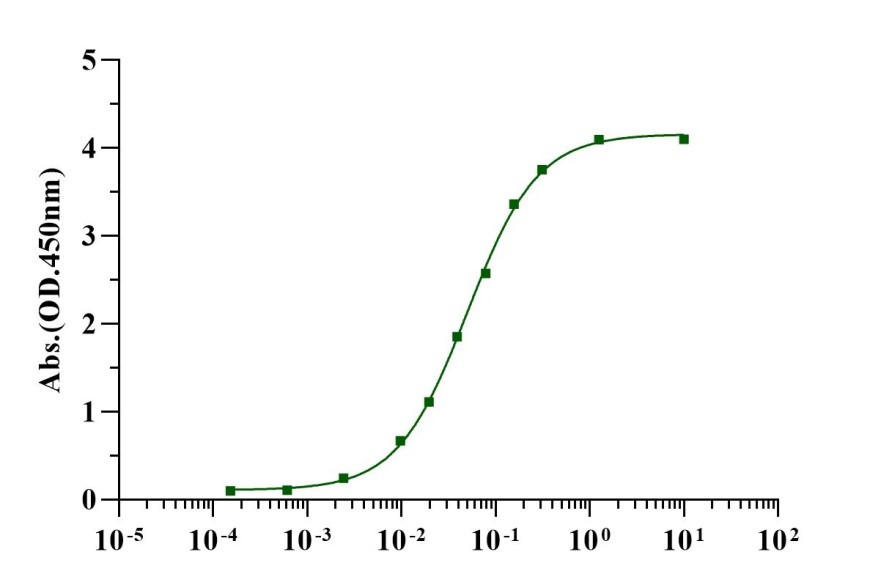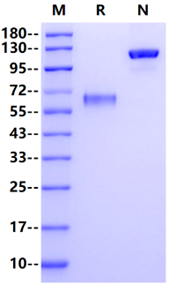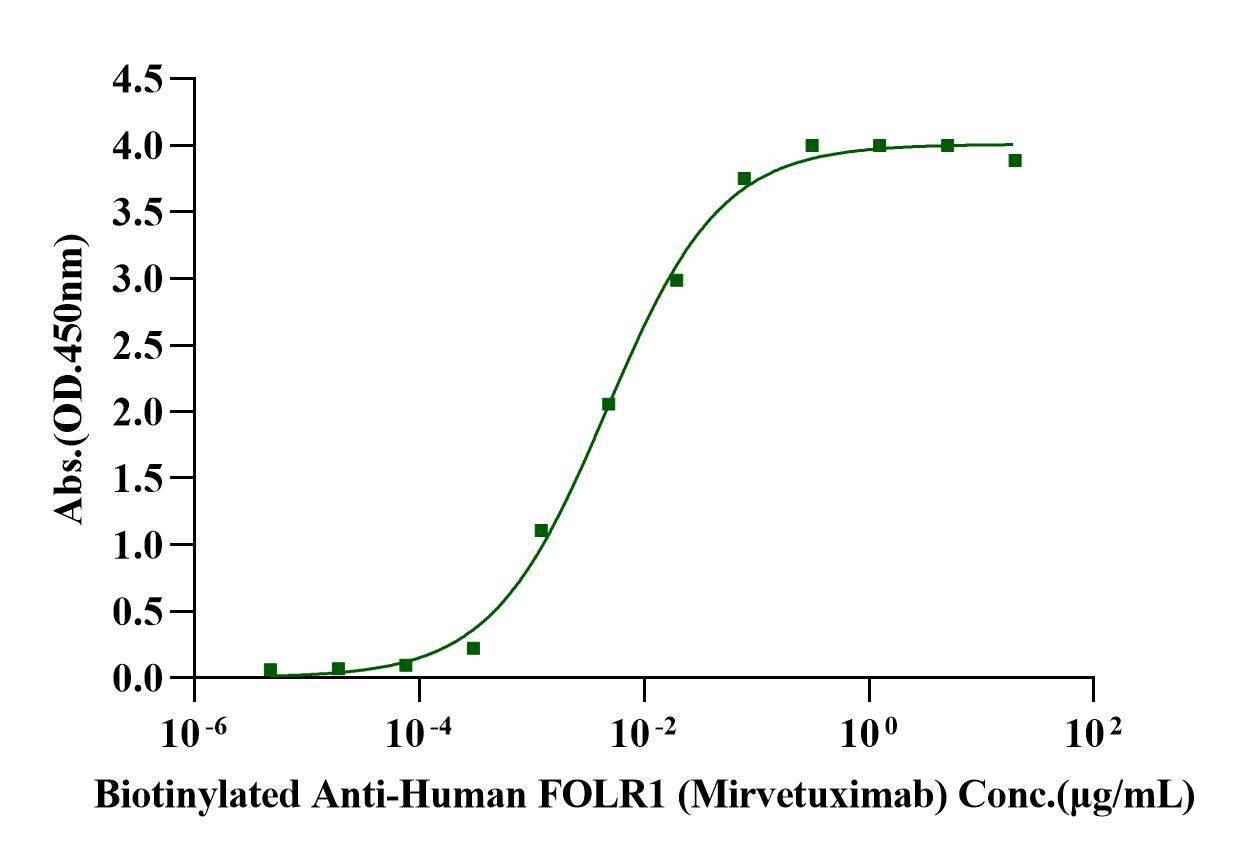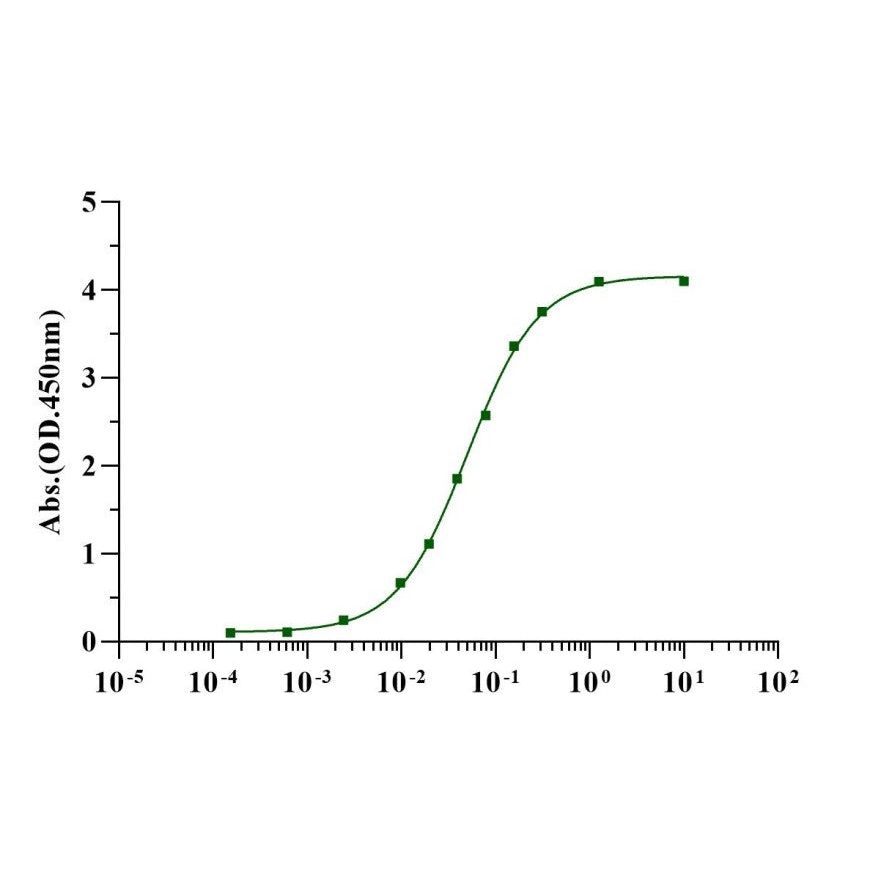Immobilized Folic acid-BSA at 2.0μg/mL (100μL/well) can bind FOLR1 Fc Chimera, Human (Cat. No. UA010117) with EC50 of 0.046-0.054μg/ml.
Product Details
Product Details
Product Specification
| Species | Human |
| Accession | P15328 |
| Amino Acid Sequence | Arg25-Met233, with C-terminal Human IgG Fc RAWARTNVCMNAKHHKKGDKHCRWRKNACCSTNTSAHKDVSYYRNWNHCGMAACKRHDTCYCSNGWVDSWRKRVNVCKDCWWDCRTSYTCKSNWHKGWNWTSGNKCAVGAACHYTTVCNWTHSYKVSNYSRGSGRCMWDAGNNVARYAAAMGGGSGGGSKSSDKTHTCCAGGSVKKDTMSRTVTCVVVDVSHDVKNWYVDGVVHNAKTKRYNSTYRVVSVTVHDWNGKYKCKVSNKAAKTSKAKGRVYTSRDTKNVSTCVKGYSDAVWSNGNNYKTTVDSDGSYSKTVDKSRWGNVSCSVMHAHNHYTKSSSGK |
| Expression System | HEK293 |
| Molecular Weight | 60-68kDa (Reducing) |
| Purity | >95% by SDS-PAGE |
| Endotoxin | <0.1EU/μg |
| Conjugation | Unconjugated |
| Tag | His Tag |
| Physical Appearance | Lyophilized Powder |
| Storage Buffer | PBS, pH7.4 |
| Reconstitution | Reconstitute at 0.1-1 mg/ml according to the size in ultrapure water after rapid centrifugation. |
| Stability & Storage | · 12 months from date of receipt, lyophilized powder stored at -20 to -80℃. · 3 months, -20 to -80℃ under sterile conditions after reconstitution. · 1 week, 2 to 8℃ under sterile conditions after reconstitution. · Please avoid repeated freeze-thaw cycles. |
Background
A biomarker of recent interest in the cancer field is folate receptor alpha (FOLR1), a membrane-bound protein with high affinity for binding and transporting folate into cells. FOLR1 is a glycosyl phosphatidylinositol connected membrane glycoprotein, consisting of 257 amino acids. The FOLR1 gene is formed of seven exons and 2 independent tissue-specific promoters, promoter 1 (P1) at the exon 1 and promoter 4 (P4) at the exon 4 whose utilization is tissue-specific. The gene is located on chromosome 11q13.3-14.1. The protein is completely exposed to extracellular molecules and anchored at the cell membrane by GPI. FOLR1 is involved in DNA replication and damage repair. FOLR1 mediates cellular responses to folate, including cell division, proliferation, and tissue growth. Overexpression of FOLR1 may confer a growth advantage to tumors by increasing folate uptake and/or may affect cell proliferation via alternative cell signaling pathways. FOLR1 levels have been found to be elevated in tumors of epithelial origin compared to normal tissue, including ovarian, breast, brain, lung and colorectal cancers. FOLR1 protein expression was lowest in normal ovarian tissue, higher in benign ovarian tumors, and highest in malignant tumors. Folate receptor alpha (FOLR1) has been identified as a potential prognostic and therapeutic target in a number of cancers.
Picture
Picture
Bioactivity

SDS-PAGE

ELISA

Immobilized FOLR1 Fc Chimera, Human (Cat. No. UA010117) at 2.0μg/mL (100μL/well) can bind Biotinylated Anti-Human FOLR1 (Mirvetuximab) with EC50 of 3.61-5.90ng/mL.






